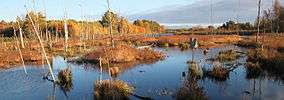Missisquoi National Wildlife Refuge
| Missisquoi National Wildlife Refuge | |
|---|---|
|
IUCN category IV (habitat/species management area) | |
 | |
 Map of the United States | |
| Location | Franklin County, Vermont, United States |
| Nearest city | Swanton, Vermont |
| Coordinates | 44°58′00″N 73°10′00″W / 44.96667°N 73.16667°WCoordinates: 44°58′00″N 73°10′00″W / 44.96667°N 73.16667°W |
| Area | 6,642 acres (26.88 km2) |
| Established | 1943 |
| Governing body | U.S. Fish and Wildlife Service |
| Website | Missisquoi National Wildlife Refuge |
Missisquoi National Wildlife Refuge is a National Wildlife Refuge located in the eastern shore of Lake Champlain in the U.S. state of Vermont. The refuge is in Franklin County in the northwest corner of the state near the International Boundary with Canada. It is the only National Wildlife Refuge located entirely in Vermont (Silvio O. Conte National Fish and Wildlife Refuge is partly in Vermont and three other states), and is administered by the United States Fish and Wildlife Service.
The refuge was established on February 4, 1943, under the authority of the Migratory Bird Conservation Act. The initial acquisition was 1,582 acres (6.4 km2) of land in the Missisquoi River delta, including Shad Island and Big Marsh Slough. Additional land was acquired over the next 60 years. The refuge's current size is 6,642 acres (27 km2). It is located in the towns of Swanton and Highgate.
Wildlife and habitat

Refuge lands support a variety of wildlife species and habitats including floodplain forest, wetlands, shrub, bog, grasslands, and upland areas.
Lands are managed to provide and protect habitat for migratory birds, to preserve the natural diversity and abundance of plants and animals, to assist with recovery of threatened and endangered species.
Federal wildlife laws and regulations are enforced to ensure the protection of habitat and wildlife.
Maquam Bog is a 900 acre pitch pine woodland bog located on the northeastern margin of Lake Champlain, Vermont. It contains Vermont's largest populations of pitch pine, rhodora, and chain fern, a state-threatened species. The bog serves as an important wintering area for white-tailed deer and provides feeding and breeding areas for a variety of birds.
Parcels of early successional hardwoods are rotationally clear cut in 8 - 10 year intervals in an effort to provide a variety of age class hardwood habitat for woodcock. Small clearcuts, usually 100 feet wide, are used on the refuge to create feeding, nesting and brood-rearing covers. Permanently mowed pieces of land adjacent to the clearcuts provide singing grounds and roosting areas for American woodcock. Woodcock, like ruffed grouse, turkey, white-tailed deer and a variety of songbirds all require forest habitat that is disturbed periodically to stimulate regeneration of dense hardwood stands that support declining woodcock populations throughout the east.
Grasslands are periodically hayed, mowed or burned to keep open field from changing back to forest. Many wildlife species benefit from these open field habitats. Waterfowl, bobolinks, and many other songbirds and small mammals use open fields to nest and rear young. Birds of prey such as American kestrel, northern harriers and rough-legged hawks glide over these same grasslands in search of prey such as mice, voles and other small mammals.
In addition to 5000 acres of natural marsh, the refuge includes 1200 acres of managed wetlands formed by three impoundments. Water levels in these areas are manipulated to encourage the growth of waterfowl food and cover plants such as wild rice and buttonbush, while also exposing hummocks of soil and vegetation that support nesting by mallards, American black ducks and other wetland birds.
Refuge habitats support the following wildlife highlights:
The largest great blue heron rookery in Vermont is located on the refuge's Shad Island. This rookery fluctuates from about 250 to almost 600 nests each year. More than 20,000 ducks converge on the refuge each fall and find habitat for feeding and resting. In the spring, a small percentage of those use the refuge habitats for nesting. Most of Vermont's black terns (up to 99%) nest on the refuge. A significant percentage of Vermont's nesting ospreys are found on the refuge. Spiny softshell turtles, a state threatened species, use the refuge to feed and bask from April through September.
External links
| Wikimedia Commons has media related to Missisquoi National Wildlife Refuge. |
- Refuge website
- The short film Missisquoi National Wildlife Refuge (2006) is available for free download at the Internet Archive
![]() This article incorporates public domain material from websites or documents of the United States Fish and Wildlife Service.
This article incorporates public domain material from websites or documents of the United States Fish and Wildlife Service.